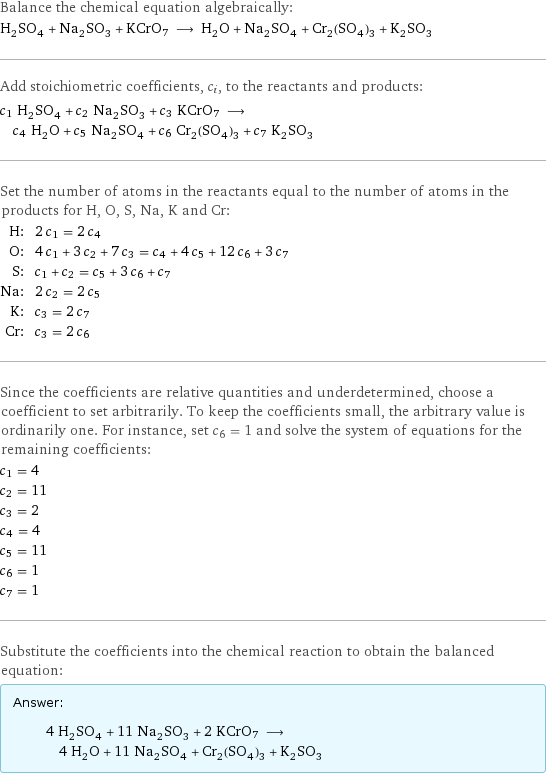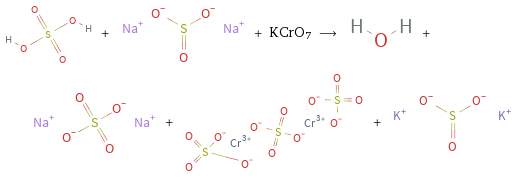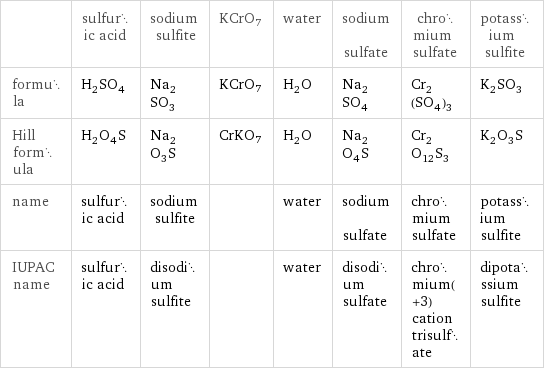Input interpretation

H_2SO_4 sulfuric acid + Na_2SO_3 sodium sulfite + KCrO7 ⟶ H_2O water + Na_2SO_4 sodium sulfate + Cr_2(SO_4)_3 chromium sulfate + K_2SO_3 potassium sulfite
Balanced equation

Balance the chemical equation algebraically: H_2SO_4 + Na_2SO_3 + KCrO7 ⟶ H_2O + Na_2SO_4 + Cr_2(SO_4)_3 + K_2SO_3 Add stoichiometric coefficients, c_i, to the reactants and products: c_1 H_2SO_4 + c_2 Na_2SO_3 + c_3 KCrO7 ⟶ c_4 H_2O + c_5 Na_2SO_4 + c_6 Cr_2(SO_4)_3 + c_7 K_2SO_3 Set the number of atoms in the reactants equal to the number of atoms in the products for H, O, S, Na, K and Cr: H: | 2 c_1 = 2 c_4 O: | 4 c_1 + 3 c_2 + 7 c_3 = c_4 + 4 c_5 + 12 c_6 + 3 c_7 S: | c_1 + c_2 = c_5 + 3 c_6 + c_7 Na: | 2 c_2 = 2 c_5 K: | c_3 = 2 c_7 Cr: | c_3 = 2 c_6 Since the coefficients are relative quantities and underdetermined, choose a coefficient to set arbitrarily. To keep the coefficients small, the arbitrary value is ordinarily one. For instance, set c_6 = 1 and solve the system of equations for the remaining coefficients: c_1 = 4 c_2 = 11 c_3 = 2 c_4 = 4 c_5 = 11 c_6 = 1 c_7 = 1 Substitute the coefficients into the chemical reaction to obtain the balanced equation: Answer: | | 4 H_2SO_4 + 11 Na_2SO_3 + 2 KCrO7 ⟶ 4 H_2O + 11 Na_2SO_4 + Cr_2(SO_4)_3 + K_2SO_3
Structures

+ + KCrO7 ⟶ + + +
Names

sulfuric acid + sodium sulfite + KCrO7 ⟶ water + sodium sulfate + chromium sulfate + potassium sulfite
Equilibrium constant
![Construct the equilibrium constant, K, expression for: H_2SO_4 + Na_2SO_3 + KCrO7 ⟶ H_2O + Na_2SO_4 + Cr_2(SO_4)_3 + K_2SO_3 Plan: • Balance the chemical equation. • Determine the stoichiometric numbers. • Assemble the activity expression for each chemical species. • Use the activity expressions to build the equilibrium constant expression. Write the balanced chemical equation: 4 H_2SO_4 + 11 Na_2SO_3 + 2 KCrO7 ⟶ 4 H_2O + 11 Na_2SO_4 + Cr_2(SO_4)_3 + K_2SO_3 Assign stoichiometric numbers, ν_i, using the stoichiometric coefficients, c_i, from the balanced chemical equation in the following manner: ν_i = -c_i for reactants and ν_i = c_i for products: chemical species | c_i | ν_i H_2SO_4 | 4 | -4 Na_2SO_3 | 11 | -11 KCrO7 | 2 | -2 H_2O | 4 | 4 Na_2SO_4 | 11 | 11 Cr_2(SO_4)_3 | 1 | 1 K_2SO_3 | 1 | 1 Assemble the activity expressions accounting for the state of matter and ν_i: chemical species | c_i | ν_i | activity expression H_2SO_4 | 4 | -4 | ([H2SO4])^(-4) Na_2SO_3 | 11 | -11 | ([Na2SO3])^(-11) KCrO7 | 2 | -2 | ([KCrO7])^(-2) H_2O | 4 | 4 | ([H2O])^4 Na_2SO_4 | 11 | 11 | ([Na2SO4])^11 Cr_2(SO_4)_3 | 1 | 1 | [Cr2(SO4)3] K_2SO_3 | 1 | 1 | [K2SO3] The equilibrium constant symbol in the concentration basis is: K_c Mulitply the activity expressions to arrive at the K_c expression: Answer: | | K_c = ([H2SO4])^(-4) ([Na2SO3])^(-11) ([KCrO7])^(-2) ([H2O])^4 ([Na2SO4])^11 [Cr2(SO4)3] [K2SO3] = (([H2O])^4 ([Na2SO4])^11 [Cr2(SO4)3] [K2SO3])/(([H2SO4])^4 ([Na2SO3])^11 ([KCrO7])^2)](../image_source/41cffaf4f1279a18d811a6dc6eac1127.png)
Construct the equilibrium constant, K, expression for: H_2SO_4 + Na_2SO_3 + KCrO7 ⟶ H_2O + Na_2SO_4 + Cr_2(SO_4)_3 + K_2SO_3 Plan: • Balance the chemical equation. • Determine the stoichiometric numbers. • Assemble the activity expression for each chemical species. • Use the activity expressions to build the equilibrium constant expression. Write the balanced chemical equation: 4 H_2SO_4 + 11 Na_2SO_3 + 2 KCrO7 ⟶ 4 H_2O + 11 Na_2SO_4 + Cr_2(SO_4)_3 + K_2SO_3 Assign stoichiometric numbers, ν_i, using the stoichiometric coefficients, c_i, from the balanced chemical equation in the following manner: ν_i = -c_i for reactants and ν_i = c_i for products: chemical species | c_i | ν_i H_2SO_4 | 4 | -4 Na_2SO_3 | 11 | -11 KCrO7 | 2 | -2 H_2O | 4 | 4 Na_2SO_4 | 11 | 11 Cr_2(SO_4)_3 | 1 | 1 K_2SO_3 | 1 | 1 Assemble the activity expressions accounting for the state of matter and ν_i: chemical species | c_i | ν_i | activity expression H_2SO_4 | 4 | -4 | ([H2SO4])^(-4) Na_2SO_3 | 11 | -11 | ([Na2SO3])^(-11) KCrO7 | 2 | -2 | ([KCrO7])^(-2) H_2O | 4 | 4 | ([H2O])^4 Na_2SO_4 | 11 | 11 | ([Na2SO4])^11 Cr_2(SO_4)_3 | 1 | 1 | [Cr2(SO4)3] K_2SO_3 | 1 | 1 | [K2SO3] The equilibrium constant symbol in the concentration basis is: K_c Mulitply the activity expressions to arrive at the K_c expression: Answer: | | K_c = ([H2SO4])^(-4) ([Na2SO3])^(-11) ([KCrO7])^(-2) ([H2O])^4 ([Na2SO4])^11 [Cr2(SO4)3] [K2SO3] = (([H2O])^4 ([Na2SO4])^11 [Cr2(SO4)3] [K2SO3])/(([H2SO4])^4 ([Na2SO3])^11 ([KCrO7])^2)
Rate of reaction
![Construct the rate of reaction expression for: H_2SO_4 + Na_2SO_3 + KCrO7 ⟶ H_2O + Na_2SO_4 + Cr_2(SO_4)_3 + K_2SO_3 Plan: • Balance the chemical equation. • Determine the stoichiometric numbers. • Assemble the rate term for each chemical species. • Write the rate of reaction expression. Write the balanced chemical equation: 4 H_2SO_4 + 11 Na_2SO_3 + 2 KCrO7 ⟶ 4 H_2O + 11 Na_2SO_4 + Cr_2(SO_4)_3 + K_2SO_3 Assign stoichiometric numbers, ν_i, using the stoichiometric coefficients, c_i, from the balanced chemical equation in the following manner: ν_i = -c_i for reactants and ν_i = c_i for products: chemical species | c_i | ν_i H_2SO_4 | 4 | -4 Na_2SO_3 | 11 | -11 KCrO7 | 2 | -2 H_2O | 4 | 4 Na_2SO_4 | 11 | 11 Cr_2(SO_4)_3 | 1 | 1 K_2SO_3 | 1 | 1 The rate term for each chemical species, B_i, is 1/ν_i(Δ[B_i])/(Δt) where [B_i] is the amount concentration and t is time: chemical species | c_i | ν_i | rate term H_2SO_4 | 4 | -4 | -1/4 (Δ[H2SO4])/(Δt) Na_2SO_3 | 11 | -11 | -1/11 (Δ[Na2SO3])/(Δt) KCrO7 | 2 | -2 | -1/2 (Δ[KCrO7])/(Δt) H_2O | 4 | 4 | 1/4 (Δ[H2O])/(Δt) Na_2SO_4 | 11 | 11 | 1/11 (Δ[Na2SO4])/(Δt) Cr_2(SO_4)_3 | 1 | 1 | (Δ[Cr2(SO4)3])/(Δt) K_2SO_3 | 1 | 1 | (Δ[K2SO3])/(Δt) (for infinitesimal rate of change, replace Δ with d) Set the rate terms equal to each other to arrive at the rate expression: Answer: | | rate = -1/4 (Δ[H2SO4])/(Δt) = -1/11 (Δ[Na2SO3])/(Δt) = -1/2 (Δ[KCrO7])/(Δt) = 1/4 (Δ[H2O])/(Δt) = 1/11 (Δ[Na2SO4])/(Δt) = (Δ[Cr2(SO4)3])/(Δt) = (Δ[K2SO3])/(Δt) (assuming constant volume and no accumulation of intermediates or side products)](../image_source/da3f74c97798ef21f74490c2a05c63df.png)
Construct the rate of reaction expression for: H_2SO_4 + Na_2SO_3 + KCrO7 ⟶ H_2O + Na_2SO_4 + Cr_2(SO_4)_3 + K_2SO_3 Plan: • Balance the chemical equation. • Determine the stoichiometric numbers. • Assemble the rate term for each chemical species. • Write the rate of reaction expression. Write the balanced chemical equation: 4 H_2SO_4 + 11 Na_2SO_3 + 2 KCrO7 ⟶ 4 H_2O + 11 Na_2SO_4 + Cr_2(SO_4)_3 + K_2SO_3 Assign stoichiometric numbers, ν_i, using the stoichiometric coefficients, c_i, from the balanced chemical equation in the following manner: ν_i = -c_i for reactants and ν_i = c_i for products: chemical species | c_i | ν_i H_2SO_4 | 4 | -4 Na_2SO_3 | 11 | -11 KCrO7 | 2 | -2 H_2O | 4 | 4 Na_2SO_4 | 11 | 11 Cr_2(SO_4)_3 | 1 | 1 K_2SO_3 | 1 | 1 The rate term for each chemical species, B_i, is 1/ν_i(Δ[B_i])/(Δt) where [B_i] is the amount concentration and t is time: chemical species | c_i | ν_i | rate term H_2SO_4 | 4 | -4 | -1/4 (Δ[H2SO4])/(Δt) Na_2SO_3 | 11 | -11 | -1/11 (Δ[Na2SO3])/(Δt) KCrO7 | 2 | -2 | -1/2 (Δ[KCrO7])/(Δt) H_2O | 4 | 4 | 1/4 (Δ[H2O])/(Δt) Na_2SO_4 | 11 | 11 | 1/11 (Δ[Na2SO4])/(Δt) Cr_2(SO_4)_3 | 1 | 1 | (Δ[Cr2(SO4)3])/(Δt) K_2SO_3 | 1 | 1 | (Δ[K2SO3])/(Δt) (for infinitesimal rate of change, replace Δ with d) Set the rate terms equal to each other to arrive at the rate expression: Answer: | | rate = -1/4 (Δ[H2SO4])/(Δt) = -1/11 (Δ[Na2SO3])/(Δt) = -1/2 (Δ[KCrO7])/(Δt) = 1/4 (Δ[H2O])/(Δt) = 1/11 (Δ[Na2SO4])/(Δt) = (Δ[Cr2(SO4)3])/(Δt) = (Δ[K2SO3])/(Δt) (assuming constant volume and no accumulation of intermediates or side products)
Chemical names and formulas

| sulfuric acid | sodium sulfite | KCrO7 | water | sodium sulfate | chromium sulfate | potassium sulfite formula | H_2SO_4 | Na_2SO_3 | KCrO7 | H_2O | Na_2SO_4 | Cr_2(SO_4)_3 | K_2SO_3 Hill formula | H_2O_4S | Na_2O_3S | CrKO7 | H_2O | Na_2O_4S | Cr_2O_12S_3 | K_2O_3S name | sulfuric acid | sodium sulfite | | water | sodium sulfate | chromium sulfate | potassium sulfite IUPAC name | sulfuric acid | disodium sulfite | | water | disodium sulfate | chromium(+3) cation trisulfate | dipotassium sulfite
Substance properties

| sulfuric acid | sodium sulfite | KCrO7 | water | sodium sulfate | chromium sulfate | potassium sulfite molar mass | 98.07 g/mol | 126.04 g/mol | 203.09 g/mol | 18.015 g/mol | 142.04 g/mol | 392.2 g/mol | 158.25 g/mol phase | liquid (at STP) | solid (at STP) | | liquid (at STP) | solid (at STP) | liquid (at STP) | melting point | 10.371 °C | 500 °C | | 0 °C | 884 °C | | boiling point | 279.6 °C | | | 99.9839 °C | 1429 °C | 330 °C | density | 1.8305 g/cm^3 | 2.63 g/cm^3 | | 1 g/cm^3 | 2.68 g/cm^3 | 1.84 g/cm^3 | solubility in water | very soluble | | | | soluble | | surface tension | 0.0735 N/m | | | 0.0728 N/m | | | dynamic viscosity | 0.021 Pa s (at 25 °C) | | | 8.9×10^-4 Pa s (at 25 °C) | | | odor | odorless | | | odorless | | odorless |
Units
